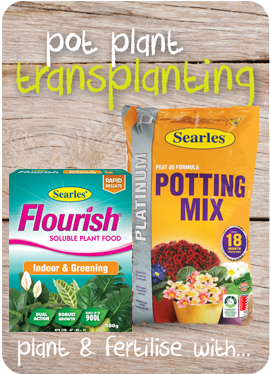Transplanting pot plants - reduce transplant shock
|
|
|
Transferring a plant from one pot to another can have some sad and unexpected consequences. Even for someone with a green thumb, their plants can suffer the effects of transplant shock. This is when the change of environment is too overwhelming for the plant, you have side effects such as leaves drooping, dropping off, leaf curl, dieback or discolouration of the leaf edges. An unhappy plant is then an invitation for pests and diseases to infest the already stricken plant. Thankfully, there are a few steps you can take to get things back on track.
As the adage goes, prevention is better than cure, which is highly applicable for transplant shock. Make sure when you first transplant the plant, that it is well watered before and after the event. Use Searles SeaMax Seaweed in the water to give it a boost of a tonic to stimulate root growth. Place the plant in the same kind of conditions that are favourable for it - don’t put an indoor plant in the sun. Try not to have the plant in a saucer of water, as often the roots can get too wet and trigger the appearance of under watering when really it is overwatered. When planting, add a quality controlled-release fertiliser such as Searles Robust Pots and Indoors, to provide adequate nutrition which will not burn any tender broken roots. Keep up regular watering, and fertilising consistently with Flourish Indoor & Greening after the first month when any broken roots or stems have healed over.
To try to avoid transplant shock by always using a premium potting mix suitable for the plant’s needs. For indoor plants, Searles Platinum Potting Mix, or for blueberries, azaleas, camellias and hydrangeas use Searles Azalea Camellia & Gardenia Specialty Mix. These premium quality mixes are designed to promote sustained healthy plant growth which is supported via the controlled release fertiliser included within the mix. Make sure the plant is not stressed, dry or pest infected before transplanting. In some cases, if the plant is root bound, or you must tinker with the root ball, you may need to prune the leaves and stems of the plant before transplanting. Often all is not lost when you have transplant shock, it just takes extra care and attention to return the plant to good health. |
--------------------------------- |






